Compare 10+ Smart Grid Solutions based on 734 user reviews
According to the US Energy Information Administration statistics, ~75% of U.S. households installed smart meters which serve as the foundation for smart grids. 1.
Smart grid solutions can improve system reliability, monitor energy production and manage energy storage. Yet, the smart grid system landscape is complicated, including diverse technologies.
Therefore, we provide a comprehensive benchmark to outline these technologies and identify top smart grid solutions.
| Company | Tech type | B2B Reviews |
|---|---|---|
| RunMyJobs by Redwood | Workload automation and job scheduling | 4.3/5.0 based on 63 reviews |
| IBM Maximo for Utilities | Enterprise asset management | 4.3/5.0 based on 266 reviews |
| Oracle Enterprise Asset Management | Enterprise asset management | 4.0/5.0 based on 154 reviews |
| Siemens | Advanced metering infrastructure | 4.5/5.0 based on 100 reviews |
| Itron | Advanced metering infrastructure | 4.6/5.0 based on 52 reviews |
| efluid by efluid SAS | Customer information system | 4.5/5.0 based on 10 reviews |
| Umax by Itineris | Customer information system | 4.8/5.0 based on 9 reviews |
| Utilities Meter Data Management by Oracle | Meter data management | 4.5/5.0 based on 29 reviews |
| Fluentgrid MDMS | Meter data management | 4.5/5.0 based on 19 reviews |
| Survalent ONE ADMS by Survalent Technology | Advanced distribution management system | 4.5/5.0 based on 18 reviews |
| ACS PRISM ADMS by Advanced Control Systems | Advanced distribution management system | 4.5/5.0 based on 14 reviews |
The table shows smart grid solutions, sorted by the number of reviews they received in their respective categories except sponsors which are listed at the top with their links. The solutions are divided into two main categories:
- Advanced Metering Infrastructure (AMI) Tools provide a complete smart meter solution.
- Complementary Tools includes workload automation (WLA), customer information systems, and other infrastructure management tools like meter data management.
These solutions were selected through the following screening process:
Screening smart metering solutions
Understanding the complexity of the smart grid solutions landscape, we focused on two key factors during the screening process:
- Solution Category is either AMI or a complementary category as outlined above.
- B2B Review Presence: Tools without any reviews on B2B review platforms were excluded from consideration.
Top 9 Complementary smart grid solutions
1. RunMyJobs by Redwood
RunMyJobs by Redwood (RMJ) specializes in workload automation (WLA) and job scheduling, providing solutions to streamline and automate complex workflows for utilities. It can be used to automate utility processes, optimize task scheduling, and improve operational efficiency for smart grids. RunMyJobs by Redwood delivers:
- Smart grid management covering the spectrum of operations from grid monitoring to grid-to-grid interactions. This approach addresses challenges associated with diverse grid components.
- Automation of grid operations can streamline tasks like load balancing, fault detection, and response mechanisms, ensuring optimal resource utilization that can contribute to the overall reliability of the smart grid.
- Real-time monitoring and control empowers grid operators with real-time insights into grid performance, energy consumption patterns, and equipment status. This capability facilitates prompt decision-making, allowing operators to respond swiftly to grid events and fluctuations, ensuring the stability and resilience of the smart grid.
- Connectivity with SAP solutions: RunMyJobs by Redwood features prebuilt connectors for S/4HANA, BTP, and other SAP solutions, facilitating integration. This can enable speed to market and help businesses preserve a clean SAP core (i.e. the integrity of the existing SAP infrastructure).
- Security measures include encryption and a single-tenant architecture to safeguard sensitive grid data and fortify the overall cybersecurity posture of the smart grid infrastructure, addressing the evolving threat landscape.
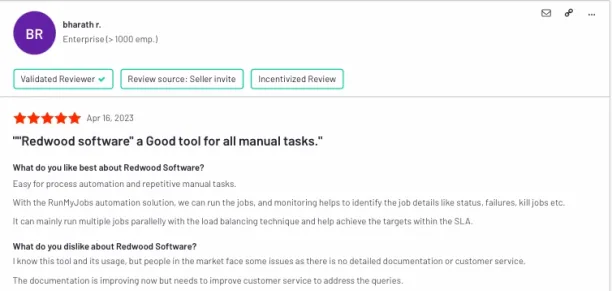
2. IBM Maximo for Utilities
IBM Maximo for Utilities, an Enterprise Asset Management (EAM) solution crafted for utility companies, excels in smart grid optimization with unique strengths:
- Comprehensive asset lifecycle management: Maximo ensures optimal performance across the asset lifecycle, covering equipment, infrastructure, and facilities crucial for smart grids (See Figure 2).
- Preventive maintenance excellence: Prioritizing preventive maintenance, Maximo reduces equipment failures, enhancing reliability and minimizing downtime in smart grid operations (See Figure 2).
- Resource optimization: Designed for efficient resource utilization, Maximo contributes to smart grid operational efficiency, optimizing equipment, infrastructure, and facility usage.
- Real-time insights and predictive analytics: Maximo provides real-time insights and predictive analytics, empowering proactive decision-making and issue response in smart grid management.
- Mobile accessibility: Maximo’s mobile accessibility enables on-the-go monitoring of smart grid assets, enhancing flexibility and responsiveness.
- Robust work order management: With robust work order management, Maximo streamlines processes like load balancing and fault detection, contributing to smart grid reliability.
- Integration capabilities: Integrating with existing systems, Maximo ensures a smooth integration process, preserving infrastructure integrity in the smart grid ecosystem.
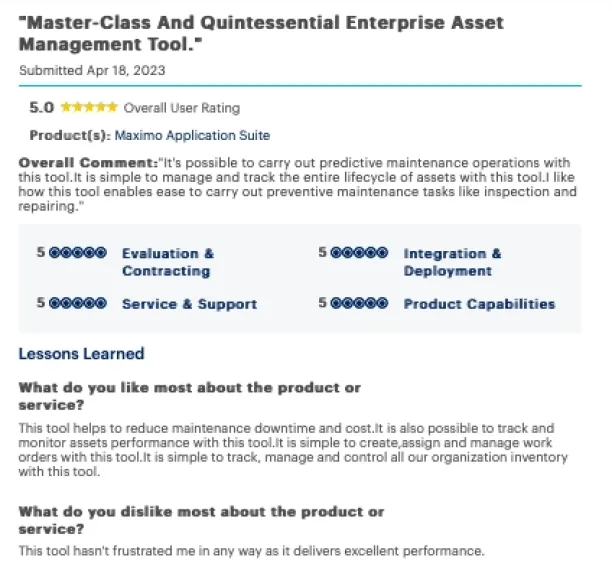
3. Oracle Enterprise Asset Management
Oracle Enterprise Asset Management (EAM) proves instrumental in smart grid optimization, standing out for its unique strengths:
- Comprehensive asset management: Oracle EAM excels in end-to-end asset management, covering work order management, maintenance planning, and asset performance monitoring crucial for smart grids.
- Oracle ecosystem integration: Oracle EAM integrates with Oracle’s broader ecosystem, providing a holistic approach to enterprise asset management. This integration enhances interoperability within the smart grid ecosystem.
- Predictive maintenance: Oracle EAM stands out for its predictive maintenance capabilities, empowering utilities to proactively address potential issues. This proactive approach reduces downtime and extends the lifecycles of smart grid assets, contributing to increased reliability (See Figure 3).
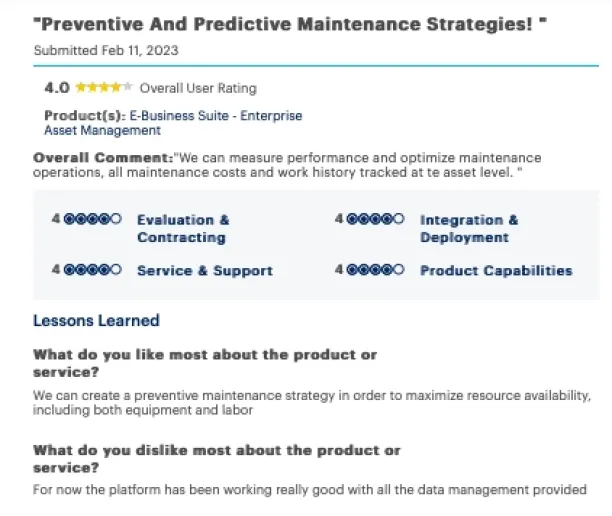
4. Efluid
Efluid by efluid SAS, a Customer Information System (CIS) solution, that helps improving utility customer-related processes by managing customer data and supporting customer interactions.
5. Umax by Itineris
Umax by Itineris, a Customer Information System (CIS) solution designed for utilities, elevates customer engagement and billing processes, offering:
- CIS functionalities can deliver end-to-end capabilities for customer engagement and billing, encompassing meter-to-cash processes and customer relationship management.
- Customer experience management focuses on providing utilities with insights into customer interactions and optimization opportunities for the billing processes.
6. Utilities Meter Data Management by Oracle
Utilities Meter Data Management by Oracle, a Meter Data Management (MDM) solution, centralizes and manages metering data with a focus on scalability and integration. The tool offers:
- Centralized meter data repository: Oracle can provide a centralized repository for meter data, streamlining data management processes crucial for accurate billing, analytics, and reporting within utility operations (See Figure 4).
- Enhanced data accuracy: Utilities Meter Data Management enables utilities to enhance data accuracy, contributing to reliable billing and supporting the integration of advanced metering infrastructure, optimizing grid operations.
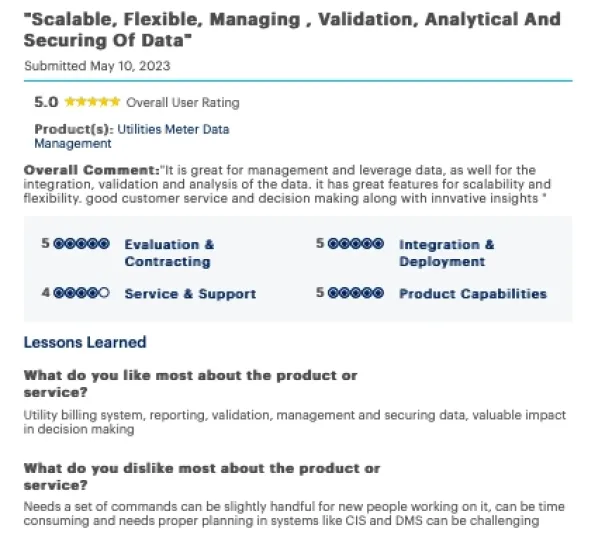
7. Fluentgrid MDM solution
Fluentgrid MDMS, a Meter Data Management (MDM) solution, prioritizes efficient meter data management and analysis for utilities with unique features, such as:
- Data-related functionalities: Fluentgrid provides functionalities for data validation, estimation, and analytics, ensuring comprehensive management and analysis of meter data for utility operations.
- Optimizing metering operations: The solution supports utilities in optimizing metering operations by managing and improving billing accuracy and overall grid performance.
- Real-time data processing: Fluentgrid MDMS can process data in real-time.This contributes significantly to the effective management of metering infrastructure.
8. Survalent ONE ADMS by Survalent Technology
Survalent ONE ADMS by Survalent Technology, an Advanced Distribution Management System (ADMS), concentrates on grid control and optimization for utilities, emphasizing real-time capabilities and comprehensive situational awareness, like:
- Real-time monitoring and managing: Survalent ONE ADMS can monitor, control, and optimize distribution networks, helping utilities gain actionable insights to their operations (See Figure 5).
- Integration of diverse devices: The solution supports the integration of diverse grid devices, smart meters, and renewable energy sources, ensuring adaptability to modern utility infrastructures.
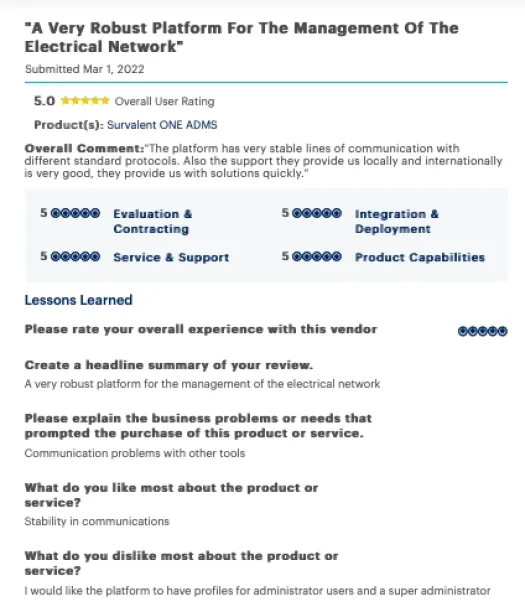
9. ACS PRISM ADMS by Advanced Control Systems
ACS PRISM ADMS by Advanced Control Systems, an Advanced Distribution Management System (ADMS), prioritizes grid optimization and distribution network performance with a focus on real-time capabilities and adaptive algorithms:
- Real-time monitoring, analytics, and control: ACS PRISM ADMS can help with real-time monitoring, analytics, and control of distribution grids, providing utilities with immediate insights into grid operations.
- Addressed management issues: The solution focuses on fault detection, outage management, and integration of distributed energy resources (DERs), addressing key challenges in modern distribution network management.
- Scalability and responsiveness: ACS can adapt to changing environment and ensures reliable and qualified service to utility providers (See Figure 6).
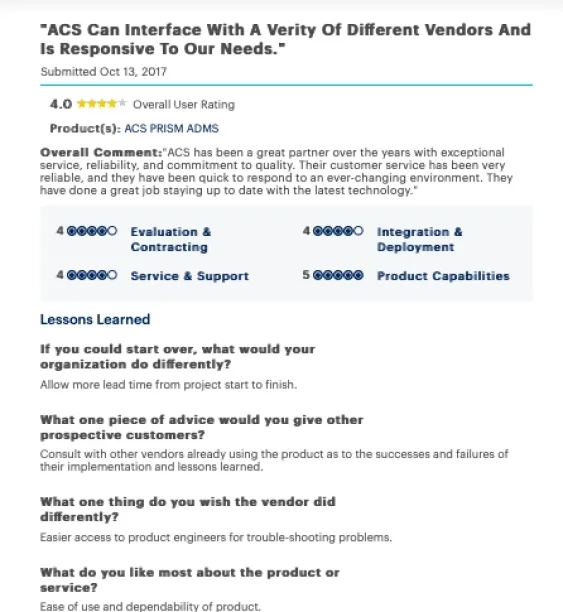
Top 2 Advanced metering infrastructure providers
10. Siemens
Siemens, a prominent provider of Advanced Metering Infrastructure (AMI) solutions, takes the lead in revolutionizing utilities’ metering capabilities, optimizing smart grid operations:
- End-to-end infrastructure: Siemens delivers end-to-end AMI solutions, integrating advanced metering, communication, and data management functionalities.
- Two-way communication: Siemens can provide secure and efficient two-way communication between utilities and meters.
- Real-time data collection: The solution enables utilities to collect real-time data, optimizing grid operations and empowering consumers with valuable insights into energy usage. This contributes significantly to building a sustainable and responsive grid (See Figure 7).
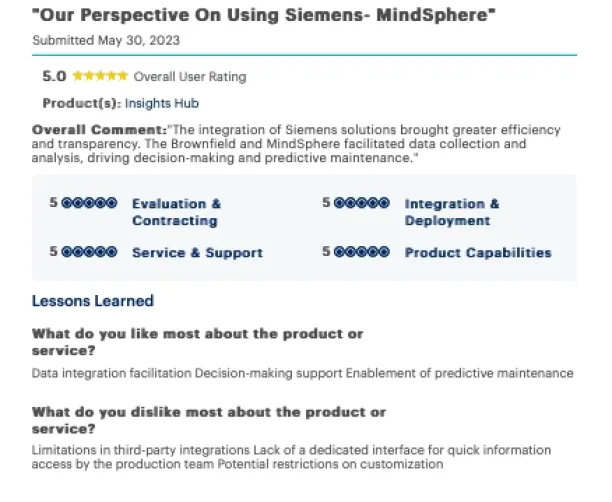
11. Itron
Itron, a specialized provider of Advanced Metering Infrastructure (AMI) solutions, optimizing grid performances by providing:
- Secure and scalable systems: Itron delivers secure, scalable, and interoperable AMI systems, ensuring enhanced grid visibility and optimal resource management for utilities.
- Real-time data collection: The solution can collect real-time data, enabling utilities to make informed decisions. This contributes to improved billing accuracy and engages customers in effective energy management, creating a more responsive and customer-centric grid.
Types of smart grid solutions and technologies
Complementary smart grid tools
These tools complement smart grid solutions by automating, orchestrating and managing smart grid operations.
Workload automation and job scheduling software
Workload automation (WLA) tools contribute to smart grid technology by enhancing operational efficiency, automating tasks, and optimizing grid performance. WLA companies deliver smart grid solutions that address the limitations of traditional power grids by:
- Enabling decentralized power generation through microgrids
- Developing complex distribution systems or allying with these distribution system operators (DSOs)
- Increasing data collection capabilities
- Reducing energy costs
- Ensuring hybrid offerings, combining renewable energy sources with traditional sources like coal and gas.
Explore WLA use cases and compare top WLA tools.
Enterprise asset management
Enterprise Asset Management (EAM) is an integral utility asset management to systematically oversee the entire lifecycle of physical assets within smart grids, optimize performance, minimize downtime, and align maintenance strategies with utility business objectives.
EAM software facilitates comprehensive planning, procurement, operation, maintenance, and retirement processes, ensuring efficient asset utilization, reduced operational risks, extended lifespan, and enhanced grid reliability while contributing to sustainable and efficient asset management practices.
CIS in utilities
CIS in utilities refers to a comprehensive software system designed to manage customer-related information and processes within the utility sector. It can streamline and optimize customer interactions, ensuring accurate billing, timely responses to inquiries, and improved overall customer satisfaction. CIS integrates data from various touchpoints, allowing utilities to maintain a centralized view of customer information. Key features often include billing and invoicing, account management, and support for customer communication.
Master data management (MDM)
Master Data Management (MDM) in the context of smart grids involves the strategic management of critical data assets within an organization. It focuses on creating and maintaining a single, consistent, and accurate version of master data across the enterprise. Master data includes information about assets, customers, locations, and other essential entities. MDM ensures data quality, integrity, and coherence, enabling utilities to make informed decisions based on a reliable foundation. This subcategory of smart grid technology supports interoperability between different systems, facilitates data sharing, and enhances the overall efficiency of data-driven processes.
Advanced Distribution Management System (ADMS)
An ADMS is a sophisticated software solution designed to enhance the real-time monitoring, control, and optimization of distribution networks within the utility sector. ADMS integrates functionalities of distribution management systems (DMS) and outage management systems (OMS), offering a holistic approach to grid operations.
It provides utilities with comprehensive situational awareness, facilitating quick responses to faults, outages, and changes in demand. Key features often include fault detection, load balancing, renewable energy integration, and adaptive control strategies. ADMS contributes to grid resilience, reliability, and the efficient management of distributed energy resources.
Advanced metering infrastructure (AMI) providers
AMI offers a holistic solution tailored for the implementation and management of advanced metering within smart grids, addressing both software and hardware components. These solutions incorporate the deployment of intelligent meters, offering real-time insights into energy consumption.
With AMI, smart grids facilitate bidirectional communication between utilities and consumers, enhancing precision in billing, enabling remote disconnect/reconnect functionality, and facilitating in-depth analysis of energy usage patterns.
Other critical smart grid technologies
SCADA
SCADA enables utilities to supervise and manage various grid components such as substations, transformers, and switchgear. SCADA systems collect and process data from sensors and remote devices, allowing operators to monitor grid conditions, detect faults, and respond promptly. With control features, SCADA allows for remote operation and intervention, enhancing grid reliability. Additionally, SCADA plays a key role in grid automation, ensuring that utilities can efficiently and effectively control and manage their infrastructure, contributing to overall grid resilience and stability.
Demand Response Management (DRM)
Utilizing real-time pricing models, DRM prioritizes demand-side management. During periods of high demand, electricity prices increase, encouraging consumers to reduce energy usage. This proactive approach helps balance the load during peak times.
Phasor Measurement Units (PMUs)
PMUs monitor electrical waves on the electricity grid using a common time source for synchronization. Time synchronization allows utilities to gather measurements at multiple locations within the distribution system, providing a comprehensive view of the system’s state.
Vehicle-to-Grid (V2G) Technologies
Also known as Vehicle-to-Grid Integration (VGI), this technology leverages the efficiency of electric vehicle batteries as energy storage systems. V2G systems transfer unused energy from vehicles back to the smart grid, assisting in balancing electricity consumption spikes and reducing grid overload during peak hours.
12 Steps to evaluate smart grid solutions
1. Real-Time Monitoring: Ensure the smart grid solution offers robust, instant monitoring capabilities.
Confirm the system provides immediate insights into power flow, consumption, and potential issues.
2. Automated Outage Management: Verify the inclusion of automated outage management features.
Assess how quickly the system restores power after outages through automated processes.
3. Enhanced Energy Management: Examine how the smart grid solution improves overall energy management.
Confirm the availability of tools for efficient utilization and optimization of energy resources.
4. Energy Usage Tracking and Management: Check if the solution enables detailed tracking and management of energy usage.
Look for features empowering both utilities and consumers to monitor and control energy consumption.
5. Electricity Consumption Reduction Opportunities: Investigate whether the smart grid solution provides opportunities to decrease and conserve electricity consumption.
Evaluate features incentivizing consumers to adopt energy-efficient practices.
6. In-House Displays: Verify the inclusion of in-house displays for effective tracking within consumer premises.
Assess the user-friendliness and comprehensibility of these displays.
7. Smart and Automated Tracking through Portals and Apps: Confirm smart and automated tracking availability through web portals and mobile apps.
Evaluate the accessibility and functionality of these platforms for both utilities and consumers.
8. Consumer Incentives: Check for mechanisms within the smart grid solution incentivizing consumers to modify energy usage for cost reduction.
Assess the effectiveness and transparency of these incentive programs.
9. Dynamic Pricing Mechanism: Verify if the solution incorporates a dynamic pricing mechanism.
Assess how well it adapts pricing based on real-time demand and supply conditions.
10. Integration for Renewable Energy: Ensure the smart grid solutions facilitate better integration for renewable energy generation.
Assess its compatibility with variable energy sources such as solar and wind power.
11. Recognition by Industry Authorities: Consider whether the smart grid solution has garnered recognition from industry authorities like the Environmental and Energy Study Institute (EESI).
Acknowledge the importance of a solution acknowledged for its role in creating an energy-efficient and sustainable power network.
12. Foundational Role for Renewable Energy Systems: Recognize the smart grid solution’s critical role as a foundation for implementing renewable energy systems into the electric grid.
Understand the significance of a demand-responsive grid for efficiently harnessing variable energy sources.
Smart grids vs. electrical grid
Traditional Electric Grid: These are also known as electricity grids and operate in a reactive manner, addressing power flow issues only when consumers report complaints. These grids rely on consumer feedback to identify and manage disparities in power flow. They may lack of visibility means the system may remain unaware of problems until consumers bring them to attention.
Smart Grid: Takes a proactive approach by continuously monitoring power flow.
– Automatically identifies potential points of failure in the electric supply.
– Equipped with advanced components, such as power transformers and distribution systems, for real-time insights.
Key Components of Smart Grid:
– Power Transformers: Gather data on power flow at crucial points.
– Main Transmission: Monitors and ensures the efficient transfer of electricity.
– Distribution System: Manages the flow of electricity to different areas.
Utility Meter (Home Supply System): Provides insights into consumer electricity usage.
Advantages of Smart Grid:
– Immediate and automatic response to power flow issues, reducing reliance on external notifications.
– Efficient use of digital technology for monitoring, control, and response.
– Establishes a direct and proactive link between utilities and consumers.
What is smart grid technology?
A smart grid is an advanced energy management system (EMS) that enhances the traditional electric grid by introducing automation, two-way communication, and IT systems. It regulates electricity production, distribution, and storage within a connected network.
Unlike analog grids, smart grids enable real-time monitoring and control of power flow between generation points and consumers.
Components of Smart Grids
Smart meters measures real-time energy consumption at the consumer’s end and provide detailed insights into consumption patterns for both consumers and energy providers.
Sensors and automation devices actively monitor voltage, current, and load capacity. They possess the capability to automatically adjust parameters, preventing overloads and mitigating large-scale blackouts.
Communication networks facilitate the exchange of data among various components such as sensors, automated devices, and control centers, serving as the backbone of the smart grid. These networks, whether wired or wireless, utilize diverse protocols and communication technologies like Wi-Fi, Z-Wave, Zigbee, and 4G/5G.
Analytics and data management tools help utilities to manage, analyze, and interpret the substantial data generated by smart grids. These tools enable providers to predict demand patterns, identify potential issues, and optimize the distribution network.
How do smart grids work?
The smart grid technology operates by:
– Integrating advanced technologies, including sensors, for precise and accurate measurements of various parameters within the electric grid.
– Implementing an automatic control system that specifically targets power distribution, identifies faults, and facilitates prompt repairs.
– establishing s a two-way communication network between the various components of the grids to facilitate seamless interaction and data exchange.
– Continuously monitoring, analyzing, and communicating throughout the energy supply chain to reduce cost and energy consumption.
– Implementing smart net meters to monitor and manage energy consumption at the consumer level.
Benefits of building smart grid solutions:
Transitioning from traditional electric grids to smart grid solutions offers various advantages in addressing contemporary energy consumption challenges:
1. Cost Efficiency: Efficient transition and distribution of electric power result in reduced costs for consumers and operational efficiency.
Lowering electric power tariff and rates can be achieved through a reduction in peak demand.
2. Improved Reliability: Smart grid solutions enhance the reliability of the grid by providing quick recovery after disturbances in feeders and lines. Large-scale load sharing and load reduction contribute to grid stability.
3. Environmental Impact: Integration with renewable energy sources like solar panels helps in reducing the environmental impact of traditional power generation methods. Meeting carbon footprint and gas emission targets becomes more achievable.
4. Addressing Energy Poverty: Smart grid solutions contribute to fighting energy poverty by making electricity more accessible and cost-effective.
5. Adaptation to Modern Consumption Patterns: The high number of consumers and increased energy requirements per individual consumer are better managed through smart grid technology. Smart grid solutions alleviate the pressure on the grid, reducing the risks of power failures.
6. Enhanced electrical distribution systems: Smart grids enhance electrical distribution systems by optimizing electricity generation and supply. They enable real-time monitoring, automated demand response, and efficient integration of renewable energy sources.
This results in improved reliability, reduced losses, and better utilization of resources, ensuring a more resilient and sustainable electricity infrastructure.
Challenges to adopt smart grid solutions
While smart grid solutions offer solutions to the flaws of traditional electric grids, integrating digital technology into the grid introduces a new set of challenges:
1. Grid reliability: Rapid changes in electricity consumption patterns necessitate proactive measures to prevent disruptions.
One way to maintain stability in the smart grid requires strategic fault management and effective FLISR technology (Fault Location, Isolation, and Service Restoration). Such systems can quickly detect and locate faults in the grid. Once a fault is identified, the system isolates the affected area and restores service to the rest of the grid promptly.
2. Grid efficiency: Power losses are a big problem in the electrical system. This happens when there are long networks of power lines, lines carrying too much electricity, or transformers that are not the right size.
To reduce these losses, it’s important to balance the amount of electricity in different parts of the system and place transformers in the right spots. One way to achieve this is to automate tasks by deploying workload automation tools (WLA). WLA tools monitor, schedule and manage the distribution of electricity, ensuring efficient workload distribution, reducing the risk of overloaded distribution lines and minimizing inefficiencies that contribute to technical losses.
3. Grid cybersecurity: The increasing digitalization of the energy sector introduces cybersecurity risks. Therefore utility companies must integrate smart grids with robust cybersecurity measures to prevent controlled blackouts and protect consumer data.
For example, these firms can mitigate cybersecurity risk by adopting penetration testing, date encryption and automating vulnerability management and security risk assessment.
Further readings
Explore more on utility automation tools by checking out our comprehensive articles:
- Compare 10 Smart Meter Solutions based on 500+ reviews
- Compare 10 SAP Utility Solutions based on 3,000+ reviews
- 10 Tips to Master Utility Asset Management
External sources
- 1. Cooper, A.; Shusterr, m.; & Lash J. (2021). “Electric Company Smart Meter Deployments: Foundation for a Smart Grid.” The Edison Foundation. Accessed at February 14, 2024.
- 2. “RunMyJobs user reviews.” G2. Accessed at February 15, 2024.
- 3. “IBM Maximo for Utilities User reviews.” Gartner. Accessed at February 15, 2024.
- 4. “Oracle EAM user review.” Gartner. Accessed at February 15, 2024.
- 5. “Oracle MDM user review.” Gartner. Accessed at February 15, 2024.
- 6. “Survalent ONE ADMS user reviews.” Gartner. Accessed at February 15, 2024.
- 7. “ACS PRISM user review.” Gartner. Accessed at February 15, 2024.
- 8. “Siemens AMI user review.” Gartner. Accessed at February 15, 2024.

![Customer Information System Utilities: 10+ solutions & 6 applications [2024]](https://research.aimultiple.com/wp-content/uploads/2024/02/CIS-google-trends-190x107.png.webp)
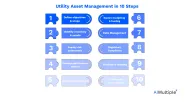
Comments
Your email address will not be published. All fields are required.